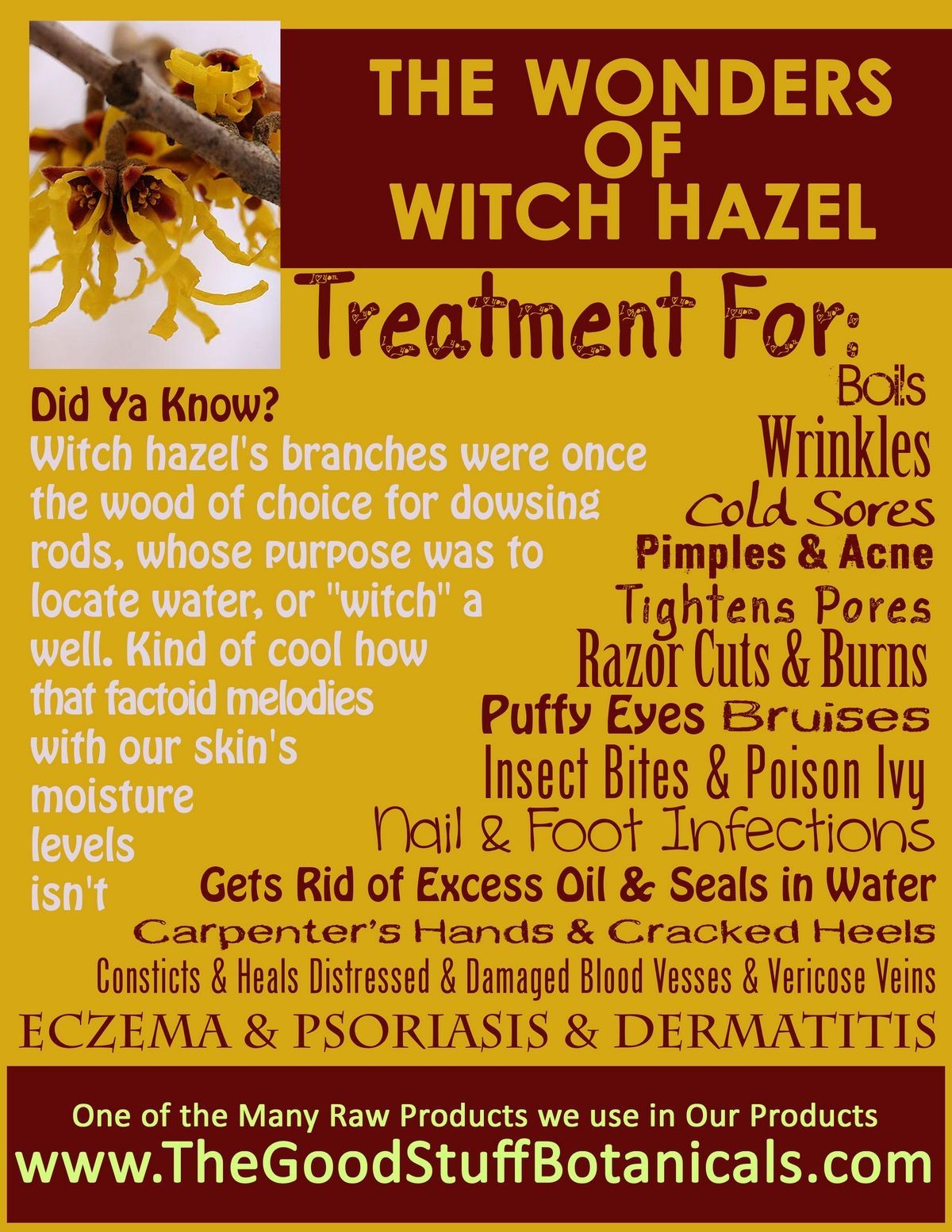
Contents
What Is Witch Hazel Used For And When Should You Not Use It?
Witch hazel is a water-based solution made with witch hazel extracts and often with added isopropyl alcohol. It is used for various skin conditions, but you shouldn’t use it if you experience burning, stinging, flushing, or other symptoms.
What is witch hazel? It’s a plant, but it can also refer to products made from that plant, most commonly a water-based solution made with witch hazel extracts and often with added isopropyl alcohol.
Witch hazel is a small tree or shrub that belongs to the Hamamelidaceae family. Hamamelis comes from the Greek word hama, meaning "at the same time," because the fruits and flowers can appear simultaneously, which is rare for plants.
There are five species of witch hazel, native to eastern North America and Asia. The most commonly used one in folk medicines is American witch hazel (Hamamelis virginica var. macrophylla).
The forked stems of the witch hazel plant have long been used as divining rods to locate underground water sources. The stem bends toward the ground when approaching a water source, a practice known as "water witching."
Today, witch hazel products can be easily found over the counter at local drugstores. They can be found in various cosmetics and skincare products, including soaps, toners, aftershaves, and after-sun lotions.
Health Benefits of Witch Hazel
For centuries, Native Americans have used witch hazel infusions of leaves, twigs, or bark to treat fever, sore throat, skin sores, sore eyes, tuberculosis, insect bites, bruises, cuts, and sore muscles.
However, limited scientific research supports the use of witch hazel for these health conditions.
Anti-inflammatory Effects
Inflammation is your immune system’s natural response to infection or injury, divided into acute and chronic inflammation. Acute inflammation occurs when you hurt your finger, resulting in swelling, pain, and redness.
Chronic inflammation, on the other hand, occurs when inflammation continues for a long time and is linked to the development of certain diseases.
Witch hazel contains plant compounds like tannins and gallic acid, which have anti-inflammatory properties. A study on 40 people found that a lotion with 10% distilled witch hazel had anti-inflammatory effects on skin that had reddened after exposure to ultraviolet light.
Reduces Skin Irritation
Nearly 45% of Americans have sensitive or very sensitive skin. Research has shown that witch hazel ointment can be as safe and effective as other ointments in improving diaper dermatitis, minor skin injuries, and skin inflammation.
Additionally, a study found that a gel containing witch hazel provided relief for irritated facial skin, with no adverse side effects.
Relieves Hemorrhoid Symptoms
Witch hazel is a popular home treatment for hemorrhoids, with creams and pastes containing witch hazel and aloe vera aiming to relieve itching and irritation of the skin.
Many hemorrhoid products use witch hazel as an active ingredient, classified as safe and effective by the US Food and Drug Administration for relief of burning and itching.
May Help with Scalp Irritation
Scalp sensitivity, characterized by a burning, tingling, or prickling feeling, can be improved with witch hazel-based shampoo, according to a study.
May Help with Acne
Witch hazel, known for its astringent properties, is commonly used in skincare products for oily skin. It acts as a pore tightener and shrinker due to its high tannin content.
May Protect Against Skin Damage
Early studies suggest that witch hazel’s tannins can neutralize free radicals and may help prevent the spread of skin cancer cells. Free radicals are unstable molecules associated with cell damage and oxidative stress.
In a study, a low dose witch hazel cream significantly reduced skin reddening when compared to chamomile cream, but it was less effective than hydrocortisone cream.
Precautions when Using Witch Hazel
If you’re pregnant or nursing, consult your doctor before using witch hazel. The effects of witch hazel on pregnancy and breastmilk are still unknown.
When Not to Use Witch Hazel
Experts recommend avoiding witch hazel products if you have rosacea or if your skin is injured, irritated, or dry.
Question:
Sources:
– American Botanical Council: "Witch Hazel"
– American Family Physician: "Treatment Options for Acne Rosacea"
– Chemical Research in Toxicology: "Highly galloylated tannin fractions from witch hazel (Hamamelis virginiana) bark: electron transfer capacity, in vitro antioxidant activity, and effects on skin-related cells"
– Clinical, Cosmetic and Investigational Dermatology: "Evaluation of a topical treatment for the relief of sensitive skin"
– Contact Dermatitis: "Contact dermatitis as an adverse reaction to some topically used European herbal medicinal products – Part 2: Echinacea purpurea – Lavandula angustifolia*," "Sensitive scalp: does this condition exist? An epidemiological study"
– European Journal of Clinical Pharmacology: "Anti-inflammatory activity of hamamelis distillate applied topically to the skin. Influence of vehicle and dose."
– European Journal of Clinical Pharmacology: "Comparative efficacy of hamamelis distillate and hydrocortisone cream in atopic eczema"
– European Journal of Pediatrics: "Hamamelis in children with skin disorders and skin injuries: results of an observational study"
– Harvard Health Publishing: "Understanding acute and chronic inflammation," "Understanding antioxidants"
– Informedhealth.org [Internet]: "Enlarged hemorrhoids: How can you relieve the symptoms yourself?"
– International Journal of Trichology: "North American Virginian Witch Hazel (Hamamelis virginiana): Based Scalp Care and Protection for Sensitive Scalp, Red Scalp, and Scalp Burn-Out"
– International Journal of Dermatology: "Sensitive skin in the American population: prevalence, clinical data, and role of the dermatologist"
– The Journal of Clinical and Aesthetic Dermatology: "Moisturizers for Acne: What are their Constituents?"
– North Carolina Extension Gardener Plant Toolbox: "Hamamelis virginiana"
– PennState Extension: "Witch Hazels: A Promise That Spring is on the Way"
– Skin Pharmacology and Applied Skin Physiology: "Anti-inflammatory efficacy of topical preparations with 10% hamamelis distillate in a UV erythema test"
– Temple Health: "How Can I Treat My Hemorrhoids?"
– University of Utah Health: "SKIN HEALTH AND FACE MASKS"
– World Health Organization. WHO Monographs on selected medicinal plants Volume 2, World Health Organization, 2002.


